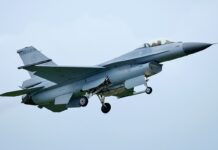US Deputy Secretary of Defense Kathleen Hicks unveiled a new Pentagon strategy on 28 August 2023 aimed directly at countering the rapid build-up of China’s People’s Liberation Army (PLA).
Placing ingenuity and innovation at the forefront of US efforts to maintain a military technological edge, Hicks said the United States will “out-match adversaries by out-thinking, out-strategising and out-manoeuvring them” during remarks made at the National Defense Industrial Association’s Emerging Technologies for Defense conference in Washington, DC.
At the heart of the new strategy, which Hicks called the Replicator Initiative, are plans for the US military to field thousands of autonomous systems across multiple domains over the next 18 to 24 months to offset China’s superiority in numbers.
“Replicator is meant to help us overcome the PRC’s [People’s Republic of China’s] biggest advantage, which is mass,” said Hicks. “More ships. More missiles. More people.”
“To stay ahead, we’re going to create a new state of the art — just as America has before — leveraging attritable, autonomous systems in all domains — which are less expensive, put fewer people in the line of fire and can be changed, updated or improved with substantially shorter lead times,” she said.
“With smart people, smart concepts and smart technology, our military will be more nimble, with uplift and urgency from the commercial sector.”
While the US Department of Defense (DoD) has long invested in autonomous systems, Hicks said that “now is the time to take all-domain, attritable autonomy to the next level: to produce and deliver capabilities to warfighters at the volume and velocity required to deter aggression, or win if we’re forced to fight”.
Hicks noted during her remarks that the Replicator Initiative is focused not only on production, but on a whole-of-department approach to innovation and the ability to quickly field technology.
In her speech Hicks made it clear that she saw the free-market economy of the West as a key enabler in striving to stay ahead of the PLA.
“We don’t seek to crush or control innovation, or make it tow the party line. Instead, our goal is to seed, spark, and stoke the flames of innovation,” she said. “That’s a big reason why the Secretary [of Defense] and I bet on our free-market system over the PRC’s statist economy any day of the week. And we still believe in our capacity to innovate – and indeed out-innovate – our competitors because we’ve seen us do it time and again.”
However, Hicks also acknowledged the challenge of what she was outlining.
“Just having an office in Silicon Valley won’t do it. That’s necessary, but not sufficient,” she said. “Just being able to do Other Transaction Authorities [OTA] agreements won’t do it. That’s necessary, but not sufficient. And even then, just doing OTAs isn’t enough, either, because once you enter a deal, that capability still must be put into warfighters’ hands, integrated into operational concepts and plans, produced at scale, and deployed to the field.
“The reality is, we face an accumulation of challenges. Most don’t lend themselves to singular broad-brush fixes,” Hicks added. “We all know the challenges and we all know the stakes. This is not about understanding the problems, or lack of leadership focus, or insufficient resources. This is about systematically tackling the highest barriers to enabling and unleashing the potential of US and partner innovations — some in DoD or our labs or elsewhere in government, but most of all outside of it.”

“All this and more is helping realise Combined Joint All-Domain Command and Control [CJADC2],” said Hicks. “This is not a platform or single system that we’re buying; it’s a whole set of concepts, technologies, policies, and talent that’s advancing a core US warfighting function: command and control. That means we first must see the whole of the defence innovation ecosystem to lower the myriad barriers that get in our way. And then, we must do the hard government work of removing those most damaging innovation obstacles.”
Among the DoD initiatives to break down innovation obstacles, Hicks noted some examples:
• the Rapid Defense Experimentation Reserve; a process to incentivise joint experimentation and hasten the pathway from concepts to experiments to fielding at scale;
• leveraging new pathways for middle-tier acquisition and software acquisition, with Hicks noting that by the end of September over USD 5.5 Bn (EUR 5.14 Bn) will have gone through the Software Acquisition Pathway across the last three fiscal years;
• other initiatives like a pilot programme to Accelerate the Procurement and Fielding of Innovative Technologies (APFIT) and Competitive Advantage Pathfinders (CAPs) to overcome bureaucratic and cultural barriers to delivering capabilities at scale to the warfighter.
As Hicks and the wider US military and defence-industrial complex strive to make the Replicator Initiative truly produce results, however, China will, of course, be looking to its own initiatives to harness the power of unmanned and attritable systems.
For the United States to prevail, therefore, it will have to both pull ahead in technological and innovation terms, productise those capabilities with agility and also protect that lead by increasingly acting to thwart Chinese espionage efforts.
Peter Felstead












